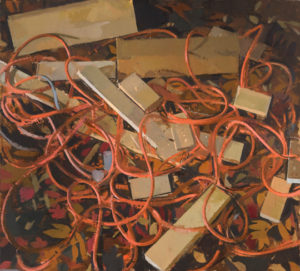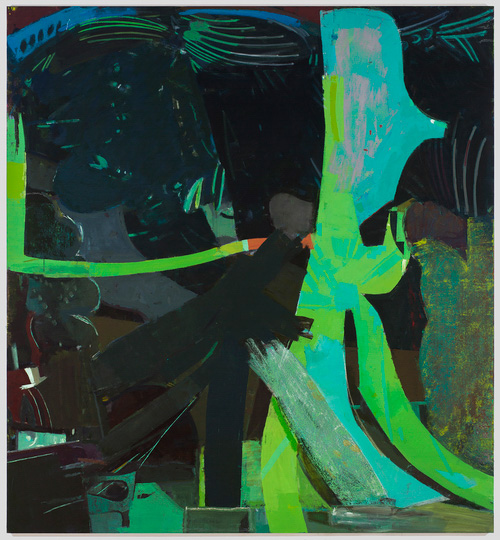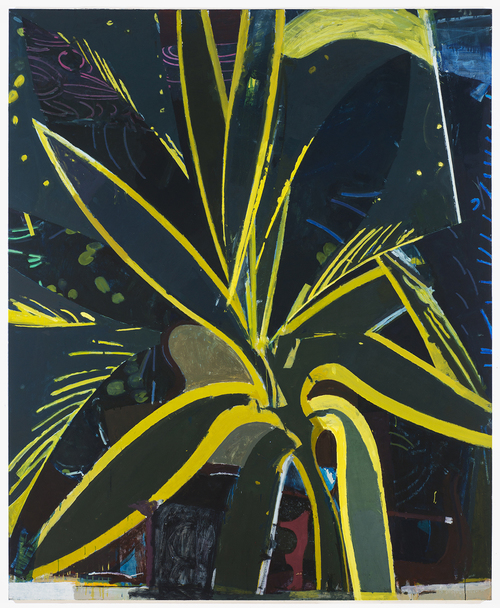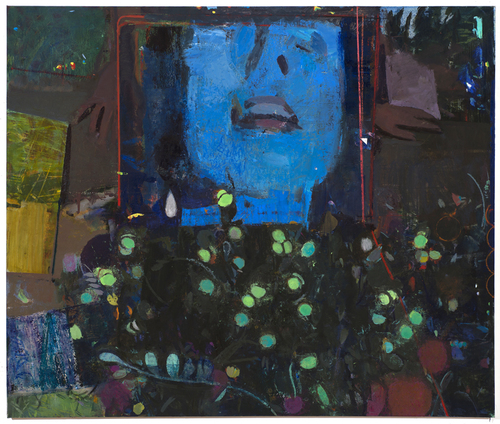The artistic fluctuations of Sangram Majumdar between the figurative and the abstract, or in that hybrid in-between, as he calls it, seem to be a reflection of his own personal story. He was born in Calcutta, India, and moved to the United States with his family when he was just 12 years old – a starting point that constitutes, in itself, a hybridization that invites to explore reality from different perspectives.
For better or worse, we are living in an era of blurred or non-existent lines for artists. It is the historical time of the 21st century, in which painters seem obligated to ask themselves the scary question, “Why do I paint?” We suffer from a complex of “being out of style,” which is not solely justified with having a good technique. It is a perverse exercise of self-justification that painters before us did not have to confront. However, it must be answered. For Sangram Majumdar, this is answered by creating an alternative or marginal space to language, as well as an alternative to the ephemeral world view of virtual images that overwhelm us. It is the private game of an observer confronting a physical and real space, that of the painting, which evokes emotion and awakens the echoes of one’s own internal conversations. To do all this, it is necessary to avoid the cliché and deliver a slice of reality, seen with new eyes.
The Studio as inspiration

Sangram Majumdar Studio
Sangram Majumdar works from his studio, which is his tool and inspirational space. To find motivation, he tends to change his environment in an attempt to find signs and possibilities of artistic expression. He takes photos and relentlessly sketches. The walls are full of drawings witnesses of his artistic exploration. It is a slow process of maturation and persistence that guides him down unknown paths. In the same painting he may incorporate figurative elements that act as catalysts toward a deeper and more complex vision. He tends to work on multiple bodies of work simultaneously, creating a “constellation of works that feed off of each other.”
Sangram Majumdar technique
Sangram Majumdar is fundamentally an oil painter and uses a wide range color palette. In the workshop we had the opportunity to share with him, he recommended the following:
Cadmium Yellow Light, Cadmium Red Light, Alizarin Crimson or Quinacridone Red, Ultramarine Blue, Viridian, Permanent Green Light, Yellow Ochre, Ivory Black, Titanium White,
Others frequently used are:
Cerulean Blue, Cobalt Blue, Indigo, Cadmium Orange,Venetian Red, Terre Verte,Raw Sienna and Naples Yellow.
With respect to paintbrushes, he uses hog bristle brushes in a wide variety of sizes, from the smallest being 2 or 4 to larger, flat paintbrushes. He is one of the few painters whom I have seen work with an “eggbert type” paintbrush with long fibers, which he handles with great mastery. He also uses spatulas when he needs to move paint or create effects. In some paintings, you can see the paint scrapings, which flush out the lower layer, showing the process and its complexity.
Sangram Majumdar is also a master of drawing, a medium that he continually uses as a study tool and means of self-expression.
In terms of the support, he uses a primed board or canvas and works with different sizes, although he likes to preserve a format in which one of the sides is 15 cm (6 inches) longer than the other. This is a compromise in which the rectangular shape maintains a balance between the vertical and horizontal orientations.
Close to things

Sangram Majumdar, “The maze”
The paintings of Sangram Majumdar’s early period are openly figurative. They showcase an artist with an extraordinary pictorial taste and impeccable technique; however, above all, you can see the seed of an open and unifying vision. At present, this drift has led him to a hybrid and poetic representation in which the object is transformed. He has largely jettisoned direct representational references in favor of seeing what happens when one ‘crossbreeds’ the traditional genres of still life, landscape and the figure.
His paintings are invitations to wander. In them, he invites the viewer to consider a simultaneous existence of the nameable and the legible, the functional and the decorative, the structural and the ‘plastic’. To quote Jean Baudrillard:
“Simply abandon all representation, forget all concern with reading, interpreting, and deciphering, and forget the critical violence of meaning and contradiction in order to recover the array of the appearance of things, there where they simply lay down their presence, in multiple shapes, multiplied by the spectrum of metamorphoses.”
Sangram Majumdar, who is defined as a painter with a non-uniform style, pursues this presence; he waits until something happens that awakens it to show us the closeness of things.












